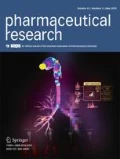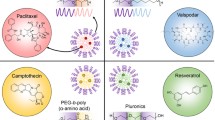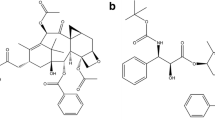Abstract
Polymeric micelles have potential utility as drug carriers. To this end, polymeric micelles based on AB block copolymers of polyethylene oxide (PEG) and poly(aspartic acid) [p(Asp)] with covalently bound Adriamycin (ADR) were prepared. The micelle forming polymer–drug conjugates [PEO-p(Asp(ADR)] were radiolabeled and their biodistribution was investigated after intravenous injection in mice. Long circulation times in blood for some compositions of PEO-p[Asp(ADR)] conjugates were evident, which are usually atypical of colloidal drug carriers. This was attributed to the low interaction of the PEO corona region of the micelles with biocomponents (e.g., proteins, cells). Low uptake of the PEO-p(Asp(ADR)] conjugates in the liver and spleen was determined. The biodistribution of the PEO-p[Asp(ADR)] conjugates was apparently dependent on micelle stability; stable micelles could maintain circulation in blood, while unstable micelles readily formed free polymer chains which rapidly underwent renal excretion. Long circulation times in blood of PEO-p(Asp(ADR)] conjugates are thought to be prerequisite for enhanced uptake at target sites (e.g., tumors).
Similar content being viewed by others
REFERENCES
M. Yokoyama, M. Miyauchi, N. Yamada, T. Okano, Y. Sakurai, K. Kataoka, and S. Inoue. Polymeric micelle as novel carrier: Adriamycin-conjugated poly(ethylene glycol)-poly(aspartic acid) block copolymer. J. Control. Release 11:269–278 (1990).
M. Yokoyama, M. Miyauchi, N. Yamada, T. Okano, Y. Sakurai, K. Kataoka, and S. Inoue. Characterization and anticancer activity of micelle-forming polymeric anticancer drug adriamycin-conjugated poly(ethylene glycol)-poly(aspartic acid) block copolymer. Cancer Res. 50:1693–1700 (1990).
M. Yokoyama, T. Okano, Y. Sakurai, H. Ekimoto, C. Shibazaki, and K. Kataoka. Toxicity and antitumor activity against solid tumors of micelle-forming polymeric anticancer drug and its extremely long circulation in blood. Cancer Res. 51:3229–3236 (1991).
M. Yokoyama, G. Kwon, T. Okano, Y. Sakurai, T. Seto, and K. Kataoka. Preparation of micelle-forming polymer-drug conjugates. Bioconjug. Chem. 3:295–301 (1992).
M. Yokoyama, G. Kwon, T. Okano, Y. Sakurai, H. Ekimoto, K. Okamoto, T. Seto, and K. Kataoka. Optimization of micelle-forming polymeric drug. Drug Target. Deliv. (in press).
E. W. Merrill and E. W. Salzman. Polyethylene oxide as a biomaterial. ASAIO J. 6:60–64 (1983).
A. Abuchowski, T. van Es, N. C. Palczuk, and F. F. Davis. Alteration of the immunological properties of bovine serum albumin by covalent attachment of polyethylene glycol. J. Biol. Chem. 252:3578–3581 (1977).
A. L. Klibanov, K. Maruyama, V. P. Torchilin, and L. Huang. Amphipathic polyethylene glycols effectively prolong the circulation time of liposomes. FEBS Lett. 268:235–237 (1990).
M. C. Woodle, G. Storm, M. S. Newman, J. J. Jekot, L. R. Collins, F. J. Martin, and F. C. Szoka. Prolonged systemic delivery of peptide drugs by long-circulating liposomes: Illustration with vasopressin in the brattleboro rat. Pharm Res. 9:260–265 (1992).
L. Illum and S. S. Davis. The organ uptake of intravenously administered colloidal particles can be altered using a non-ionic surfactant (poloxamer 338). FEBS Lett. 167:79–82 (1984).
R. Duncan and J. Kopechek. Soluble synthetic polymers as potential drug carriers. Adv. Polym. Sci. 57:51–101 (1984).
L. B. Wingard, T. R. Tritton, and K. A. Egler. Cell surface effects of adriamycin and carminomycin immobilized on crosslinked poly vinyl alcohol. Cancer Res. 45:3529–3536 (1985).
C. Zhao, M. A. Winnik, G. Riess, and M. D. Croucher. Fluorescence probe technique used to study micelle formation in water-soluble block copolymers. Langmuir 6:514–516 (1990).
K. Prochazka, D. Kiserow, C. Ramireddy, Z. Tuzar, P. Munk, and S. E. Webber. Time-resolved fluorescence studies of the chain dynamics of naphthalene-labeled polystyrene-block-poly(methacrylic acid) micelles in aqueous media. Macromolecules 25:454–460 (1992).
A. Gabizon and D. Papahadjopoulos. Liposome formulations with prolonged circulation time in blood and enhanced uptake by tumors. Proc. Natl. Acad. Sci. 85:6949–6953 (1988).
Author information
Authors and Affiliations
Rights and permissions
About this article
Cite this article
Kwon, G.S., Yokoyama, M., Okano, T. et al. Biodistribution of Micelle-Forming Polymer–Drug Conjugates. Pharm Res 10, 970–974 (1993). https://doi.org/10.1023/A:1018998203127
Issue Date:
DOI: https://doi.org/10.1023/A:1018998203127




